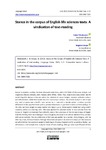Stance in the corpus of English life sciences texts: A vindication of text-reading

Use este enlace para citar
http://hdl.handle.net/2183/34127
Excepto si se señala otra cosa, la licencia del ítem se describe como Atribución-NoComercial 4.0 Internacional
Colecciones
- Investigación (FFIL) [877]
Metadatos
Mostrar el registro completo del ítemTítulo
Stance in the corpus of English life sciences texts: A vindication of text-readingFecha
2023Cita bibliográfica
Moskowich, I., & Crespo García, B. (2023). Stance in CELiST: A vindication of text - reading. Language Value, 16(1), 1-22. https://doi.org/10.6035/languagev.7186
Resumen
[Abstract] Stance in academic writing has been discussed extensively within the fields of discourse analysis andpragmatics (Alonso-Almeida, 2015; Hyland,2005; White, 2003). Thus, Hyland and Jiang (2016) identify certain linguistic elements that are said to be indexical of stance: hedges, boosters, attitude markers, and self-mentions. While that model aims at a macroscopic analysis, the present study is a microscopic one, and compares two scientific texts written by a male and a female author to detect possible differences in the way that these authors present themselves or give their opinions in their writings. To this end, we have sought to apply Hyland and Jiang’s (2016) three-aspects modelbutusing Cesiri’s inventory (2012) as a starting point. We have applied this adapted model to two samples from the Corpus of English Life Sciences Texts (CELiST), one of the subcorpus of the Coruña Corpus of English Scientific Writing. Both texts belong to the same genre, are dated at an almost identical time, and deal with similar subjects. The only difference is that one was written by a woman, Emily Gregory, and theother by a man, Alpheus Packard. Although these texts are part of an electronic corpus, on this occasion we will avoid the automatic analytical techniques of corpus linguistics asfaras possible. Rather, we will conduct a microscopic-level study by means of close reading, although some quantification of data will precede the qualitative analysis where this is useful. It is hoped that the qualitative focus presented in theanalysis might open up new paths in the study of stance.
Palabras clave
Stance
Coruña Corpus
Sex of authors
Late Modern English
Scientific/academic writing.
Coruña Corpus
Sex of authors
Late Modern English
Scientific/academic writing.
Versión del editor
Derechos
Atribución-NoComercial 4.0 Internacional
ISSN
1989-7103






